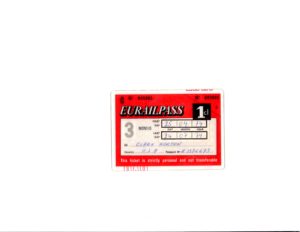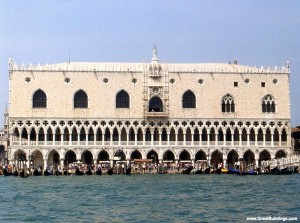
You can now reach Budapest by Eurail pass. The Hungarian Parliament Building, illuminated at night. Photo by Clark Norton
Ah, the early ’70s — the halcyon days when I and countless other baby boomers explored Europe (or at least Western Europe) with our trusty Eurail passes, which offered virtually unlimited travel on Western European railways for periods up to three months.
And as I recall, I paid the grand sum of $300 for a three-month pass — and that was for first-class seating.
True, I was usually one of the scruffiest riders in first class at that time — I often used to sleep on the trains to save money, since my budget was the proverbial $5 a day — but in exchange for sharing a compartment mostly with staid businessmen and properly dressed ladies, I had comfortable seating and hardly ever had to stand out or even sleep in the hallways, as I frequently did when traveling second class on previous trips.
And, on a whim — say, if it was raining in Milan in the afternoon — I could hop on a train and take the scenic route to Zurich for dinner, then catch the overnight train back to Italy. (And yes, I did do exactly that.)
The pass was even good for ferries on Swiss lakes and some other bonus forms of transport. And with most European trains running on time — Spain was a notable exception back then — and with great frequency, it was no doubt the greatest travel bargain I’ll ever see in my lifetime.
Things Change
Eurail passes — which are not available to European residents — remain popular with American travelers. The U.S. is the largest market for them globally, and North America accounts for 38 percent of global market share — with sales in the U.S. and Canada jumping almost 16 percent from 2014 to 2015.
And no wonder. By my count, 15 countries have been added to the 13 that were available back when I was riding the rails across Western Europe.
These include desirable (and sometimes off-the-beaten-track) destinations such as Ireland, Finland, Greece, the Czech Republic, Slovakia, Hungary, Poland, Bulgaria, Romania, Turkey, and five of the former Yugoslav republics that are now independent countries: Croatia, Slovenia, Serbia, Montenegro, and Bosnia-Hercegovina. (The UK doesn’t participate in Eurail.)
You can also ride all through Germany, whereas before 1990, East Germany (and thus Berlin, Dresden and other sites) was off limits.
Perhaps needless to say, Eurail passes cost more now. And there are other rules that didn’t use to apply, since many of the passes only allow travel within certain countries and for a certain number of days.
You could look at the latter rules as “restrictions, ” but you could also view them as “flexibility” — allowing you to save money if you’re only planning to visit a few countries within a specific time period.
So rather than the one “global” pass that was available back in the early ’70s , there are now dozens of other possibilities to choose from.
Which one you choose could end up saving you a bundle of money — or costing you more than you care to calculate.
The Good Old Global Pass
The Global Pass — covering continuous travel in up to 28 countries — remains a popular choice, albeit the most expensive one. Three months of first-class travel will cost an adult (age 26 and up) $1,867.
Still, accounting for inflation — everything seems to be at least six times more expensive now (if not more) than in the early ’70s — $1,867 seems right in the ballpark with the $300 of yore.
Even better, if you take all your train trips with a companion, you’ll each receive a 15 percent discount, which lowers the price per person to $1,589. (Just make sure you’re traveling with someone you really like and are compatible with.)
If you don’t have three months to spare, you can choose continuous travel passes of 15 days, 22 days, one month, or two months, starting at $679 per person.
Again, adjusting for inflation and considering all the additional countries covered, we’re now getting back into truly bargain territory.
And if you’re traveling with kids or grandkids under 12, two can ride for free with one paying adult.
Other Options
Most travelers of baby boomer age probably aren’t going to try to see 28 countries in one trip, or even remotely that many, grandkids or no in tow. And you may not want to take trains as often as every day or every other day.
If so, you can opt for, say, a two-month Global Pass in which you can travel by train just 15 out of the 60 or so days — and save nearly $500 by doing so.
Or you could opt for traveling just seven days out of a one-month period — and save more than $400 off a continuous pass.
Now it gets even more complicated.
It’s now possible to save more money by buying “Select” passes that are valid for two months in just four countries, or three, or two, or even one. But if it’s two or more, you have to choose countries that border each other — or pay extra for the additional country or countries you’re traveling through.
For instance, you might choose France-Germany-Italy-Switzerland for your four countries. Or Austria-Germany-Czech Republic-Hungary. All run contiguously.
For three countries, you might choose Benelux-France-Germany. (This is a particularly good deal because the Benelux countries — Belgium, Netherlands, and Luxembourg — count as one.) Or France-Spain-Portugal.
For two countries, you might choose France-Spain or Bulgaria-Turkey.
The former Yugoslav republics offer a break since Croatia and Slovenia are grouped together as one, as are Serbia and Montenegro — so you could see four countries for the price of two.
Besides those pairings, you could get especially good deals by choosing the three Benelux countries; Scandinavia (since Denmark, Norway, Sweden, and Finland now count as one); or the Greek Islands, which includes two international ferry trips between Italy and Greece and four domestic ferry trips within Greece.

Hagia Sophia (Church of the Holy Wisdom) at dawn in Istanbul, Turkey. Photo by Dennis Cox/WorldViews
Of course, once you’ve chosen your countries, you then need to decide the number of days you want to travel within a two-month period, with prices ranging from $413 to $600 for two adults traveling together, depending on whether you pick five, six, eight or ten days.
Whew.
Plan Ahead
So the key to saving money on Eurail passes is planning — just like it is for many other aspects of travel.
You’ll need to map out, as best you can, the routes you’ll want to travel and when, to make the most of your passes. If you aren’t sure of how many days you’ll want to actually ride the trains, it’s probably best to err on the side of more days, providing maximum flexibility.
Start early — you can buy your Eurail passes up to 11 months in advance of when you actually take your first ride.
There’s one other wrinkle I need to mention that I didn’t have to deal with in the old days. That’s that most European high-speed and night trains now require advance reservations. You can also reserve seats on other trains that don’t require reservations, to ensure that you will actually be able to sit down on a full train.
And, depending on the train and country, reservations aren’t always cheap. Some go for as little as three euros, but others, such as luxurious high-speed trains connecting France and Switzerland, may run you more than 50 euros in first class.
Night train reservations vary widely by type of accommodation. If you choose to sleep in your seat — many of which recline, at least somewhat — you might pay nine or ten euros. But a double deluxe sleeper with private bath could run more than 80 euros per person (and singles nearly 125 euros). Couchettes — six or eight-person dorm-style sleeper cars — fall somewhere in between.
These charges, again, are in addition to the original price of your Eurail pass.
You can make reservations at train stations in Europe, or, for an additional fee of six to eight euros, at the Eurail.com reservations desk. The latter will save you time and perhaps the aggravation of visiting and waiting at the train stations, but can add up quickly in expense.
The best way to avoid these fees altogether is to ride regional trains, but these can be much slower and more crowded than the pricey ones.
The bottom line is that riding the rails in Europe is more complicated than it used to be. But it’s still a fantastic way of generally getting around in comfort, efficiency, and style.
Note: Eurail is not to be confused with Rail Europe, which is authorized to sell Eurail passes in the U.S. but sells other European train passes as well, which give you even more options!
You might also be interested in reading this previous post on Eurail passes.
Bonus: Where American Eurail Travelers Go Most
The 10 most popular routes for American Eurail Global Pass holders in 2015 were:
- Florence to Rome
- Berlin to Prague
- Munich to Salzburg
- Prague to Vienna
- Budapest to Vienna
- Florence to Venice
- Amsterdam to Berlin
- Florence to Pisa
- Amsterdam to Rotterdam
- Fuessen to Munich















Leave a Reply